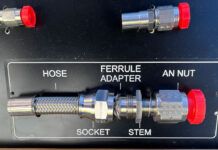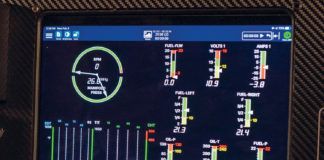New Electronic Flight Instrument Systems (EFISes) seem to arrive every day. At AirVenture this summer, familiar manufacturers and newcomers alike displayed new electronic instruments. Among them was PC Avionics, creator of the MountainScope moving-map software. Its new line, called yourGlassPanel, consists, for now, of two sizes of independent “boxes” intended for new installations but engineered for a simplified retrofit into existing panels.
To that end, both of the new YGP units fit into standard instrument holes-with 2.25- (the YGP-2) and 3.125-inch (the YGP-3) versions. As is true of other “overlay” displays, the front end overlaps the instrument hole slightly, so its worth measuring around the existing locations-and taking this into account for new panels
-to ensure there’s no interference. The larger instrument is 3.375 inches wide by 3.5 inches tall; the smaller is 2.375 inches square in front of the panel.
Capability and Expandability
Into this compact package, PC Avionics has squeezed a fair bit of capability and a lot of expandability. For example, each of the two front-panel buttons is actually a four-way quasi-joystick plus a fifth function when you press straight in. The front-panel USB port will allow simplified updating and expansion. The standard DB-25 connector at the back accepts power (with a dedicated line for an external backup battery that also keeps it charged), audio in and out (not yet implemented) plus three serial connections, RS-232, RS-422 and RS-485.
In the configuration we tested, the larger YGP, the internal sensor pack was still in development, but the device can accept outside ADAHRS data from Crossbow, Dynon and Grand Rapids sensors as well as from the PC Flight Systems eGyro-XP or eGyro-GC sensor packs. (These last two have been mated with the MountainScope software to provide a portable, PDA-based EFIS in the past.) Price for the basic display is $1195 (either size) or $2495 with an internal ADAHRS module.
Put to the Test
In flight, the YGP-3 performed flawlessly, mimicking the information also displayed on the Dynon D-100 supplying the flight data, as you would expect. The five-way switches, though small, were not difficult to activate, and the functions were intuitive.
Each of the standard instrument displays-airspeed, altimeter, directional gyro, G meter, turn coordinator and vertical speed-is artfully presented. Another choice includes a basic attitude indicator or one with an EFIS presentation of attitude, altitude, airspeed, heading and slip/skid ball. It worked great but we wish for wider pitch gradations; picking up small pitch changes is more difficult than with the expanded-scale Dynon.
Screen brightness was not quite up to the “bright screen” Dynon next to it, but thats not the whole story. This display is made to be resistant to washing out from direct sunlight, and in this regard it does quite well. Overall, the YGP-3s screen was legible even with direct sunlight on it.
For builders wanting a simple primary EFIS, the YGP line is a fine choice, but it may also find favor among those looking for an inexpensive (relatively) backup to other glass; with the eGyro package, a YGP would run around $1800, less than an electric mechanical attitude indicator. Moreover, either YGP would work
a treat for owners of tandem-seat aircraft seeking nothing more than a repeater screen for the back seater. Ultimately, the yourGlassPanel instrument is an excellent first effort.
For more information, visit www.yourglasspanel.com













